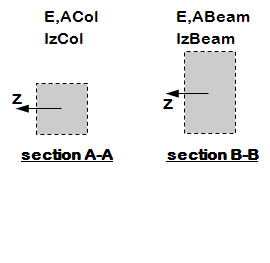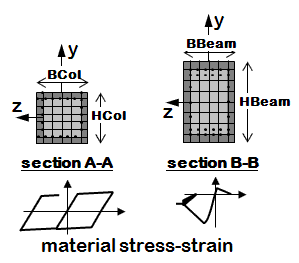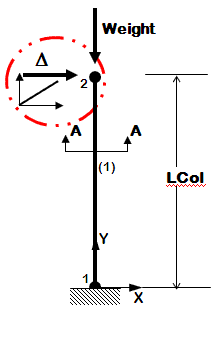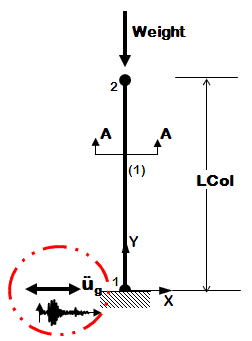OpenSees Example 4. Portal Frame: Difference between revisions
(Created page with '__NOTOC__ ==Introduction== The principal features of this example is the introduction of units and the separation of the model-building and the analysis portions of the input fil…') |
No edit summary |
||
| Line 1: | Line 1: | ||
__NOTOC__ | __NOTOC__ | ||
==Introduction== | ==Introduction== | ||
This is a great example! | |||
To all the demonstrations that Example 3 has done, Example 4 adds the use of previously-defined Tcl procedures (a procedure is a Tcl command that is created by the proc command) or scripts. | |||
This example also introduces new kinds of static and dynamic analyses. | |||
==Input== | ==Input== | ||
| Line 22: | Line 25: | ||
|- | |- | ||
| style="color:#000;" | <div> | | style="color:#000;" | <div> | ||
[[File: | [[File:ExampleFigure_ElasticSection.GIF|link=OpenSees Example 4. Portal Frame]] | ||
---- | ---- | ||
<strong>Files</strong> | <strong>Files</strong> | ||
*[[Media: | *[[Media:Ex4.Portal2D.build.ElasticElement.tcl|Ex4.Portal2D.build.ElasticElement.tcl]] | ||
*[[Media:LibUnits.tcl|LibUnits.tcl]] | |||
---- | ---- | ||
<strong>Notes</strong> | <strong>Notes</strong> | ||
| Line 39: | Line 43: | ||
|- | |- | ||
| style="color:#000;" | <div> | | style="color:#000;" | <div> | ||
[[File: | [[File:ExampleFigure_UniaxialSection.GIF|link=OpenSees Example 4. Portal Frame]] | ||
---- | ---- | ||
<strong>Files</strong> | <strong>Files</strong> | ||
*[[Media: | *[[Media:Ex4.Portal2D.build.InelasticSection.tcl|Ex4.Portal2D.build.InelasticSection.tcl]] | ||
*[[Media:LibUnits.tcl|LibUnits.tcl]] | |||
---- | ---- | ||
<strong>Notes</strong> | <strong>Notes</strong> | ||
| Line 57: | Line 62: | ||
|- | |- | ||
| style="color:#000;" | <div> | | style="color:#000;" | <div> | ||
[[File: | [[File:ExampleFigure_FiberSection.GIF|link=OpenSees Example 4. Portal Frame]] | ||
---- | ---- | ||
<strong>Files</strong> | <strong>Files</strong> | ||
*[[Media: | *[[Media:Ex4.Portal2D.build.InelasticFiberSection.tcl|Ex3.Canti2D.build.InelasticFiberSection.tcl]] | ||
*[[Media:LibUnits.tcl|LibUnits.tcl]] | |||
---- | ---- | ||
<strong>Notes</strong> | <strong>Notes</strong> | ||
| Line 86: | Line 92: | ||
|- | |- | ||
| style="color:#000;" | <div> | | style="color:#000;" | <div> | ||
[[File:Example3_Push.GIF|link=OpenSees Example | [[File:Example3_Push.GIF|link=OpenSees Example 4. Portal Frame]] | ||
---- | ---- | ||
<strong>Files</strong> | <strong>Files</strong> | ||
| Line 102: | Line 108: | ||
|- | |- | ||
| style="color:#000;" | <div> | | style="color:#000;" | <div> | ||
[[File:Example3_EQ.GIF|link=OpenSees Example | [[File:Example3_EQ.GIF|link=OpenSees Example 4. Portal Frame]] | ||
---- | ---- | ||
<strong>Files</strong> | <strong>Files</strong> | ||
Revision as of 18:56, 11 November 2009
Introduction
This is a great example! To all the demonstrations that Example 3 has done, Example 4 adds the use of previously-defined Tcl procedures (a procedure is a Tcl command that is created by the proc command) or scripts. This example also introduces new kinds of static and dynamic analyses.
Input
Model Building
The following tasks are performed when building the model
- define units
- define model
- define recorders for output
- define & apply gravity
Elastic Element
|
Distributed Plasticity Element, Uniaxial Section
|
Distributed Plasticity Element, Fiber Section
|
Lateral-Load Analysis
The following tasks are performed in the analysis
- define lateral-load parameters
- analyze
Static Pushover
|
Dynamic EQ Ground Motion
|
Run
The following combinations of model-building and analysis can be performed with this example:
- To run Elastic Mode, Static Pushover Analysis:
puts " -------------Elastic Model -------------" puts " -------------Static Pushover Analysis -------------" source Ex3.Canti2D.build.ElasticElement.tcl source Ex3.Canti2D.analyze.Static.Push.tcl
- To run Elastic Mode, Uniform Earthquake Excitation:
puts " -------------Elastic Model -------------" puts " -------------Uniform Earthquake Excitation -------------" source Ex3.Canti2D.build.ElasticElement.tcl source Ex3.Canti2D.analyze.Dynamic.EQ.Uniform.tcl
- To run Uniaxial Inelastic Section, Nonlinear Model, Static Pushover Analysis
puts " -------------Uniaxial Inelastic Section, Nonlinear Model -------------" puts " -------------Static Pushover Analysis -------------" source Ex3.Canti2D.build.InelasticSection.tcl source Ex3.Canti2D.analyze.Static.Push.tcl
- To run Uniaxial Inelastic Section, Nonlinear Model, Uniform Earthquake Excitation
puts " -------------Uniaxial Inelastic Section, Nonlinear Model -------------" puts " -------------Uniform Earthquake Excitation -------------" source Ex3.Canti2D.build.InelasticSection.tcl source Ex3.Canti2D.analyze.Dynamic.EQ.Uniform.tcl
- To run Uniaxial Inelastic Material, Fiber Section, Nonlinear Mode, Static Pushover Analysis
puts " -------------Uniaxial Inelastic Material, Fiber Section, Nonlinear Model -------------" puts " -------------Static Pushover Analysis -------------" source Ex3.Canti2D.build.InelasticFiberSection.tcl source Ex3.Canti2D.analyze.Static.Push.tcl
- To run Uniaxial Inelastic Material, Fiber Section, Nonlinear Mode, Uniform Earthquake Excitation
puts " -------------Uniaxial Inelastic Material, Fiber Section, Nonlinear Model -------------" puts " -------------Uniform Earthquake Excitation -------------" source Ex3.Canti2D.build.InelasticFiberSection.tcl source Ex3.Canti2D.analyze.Dynamic.EQ.Uniform.tcl
Notes
- This example is the first to follow most of the recommended techniques in building an input file:
- Model and analysis parameters are defined as variables
- The basic units, used to define Force, Length and Time need to be independent.
- Units need to be used consistently throughout the input file, otherwise some arguments will not scale properly
- The model-building files and the analysis files are separated. The same analysis file can be used on different model-building files (elastic or inelastic elements).
- This example does not, however, take advantage of previously-defined Tcl procedures and scripts, as will Example 4.
- In OpenSees/Tcl, units are simply defined as variables that become scaling factors. This technique allows the user to input variables with different types of units, not just the ones chosen for output. For example, section widths can be defined in inches, while element length can be defined in feet.
For example, with the following commands used in setting some of the units:
set in 1.; # define basic units -- output units set kip 1.; # define basic units -- output units set sec 1.; # define basic units -- output units # ------- set ft [expr 12.*$in]; # define engineering units set ksi [expr $kip/pow($in,2)];When the user says:
set HCol [expr 3*$in]; set LCol [expr 30*$ft];Tcl multiplies 30 by 12 to give the column length in inches. By scaling the input, all input processed by OpenSees is in the basic units, as is the output.
Return to OpenSees Examples Manual
Return to OpenSees User



